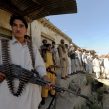After Bajaur Strike, Peace Deal with Agency Militants Still Ahead
Publication: Terrorism Focus Volume: 3 Issue: 43
By:

On October 30, Pakistan bombed a religious school in Bajaur Agency in the Federally Administered Tribal Areas (FATA) on the very day it was set to sign a peace deal with those who ran the school. In anticipation of the deal, Islamabad had even released a number of key Taliban leaders from jail to enable them to lobby the hold-outs who objected to the deal (Gulf Times, October 13). Yet, Pakistani President Pervez Musharraf said that the religious facility was recently detected for hosting militant activities (Dawn, October 31). On the contrary, however, the Taliban had been operating out of the bombed-out facility, a surviving wall of which still proclaims Hayya Illul Jihad (come unto jihad), since 2001 when they were driven out of Afghanistan. Bajaur, which is home to the pro-Taliban Tehreek-e-Nafaz-e-Shariat-e-Mohammadi (TNSM), became their sanctuary of choice. This sanctuary was even more significant for its strategic advantage since it was closely placed to the Wakhan strip of Afghanistan, which borders Pakistan, Tajikistan, Uzbekistan and China. This proximity brought the Taliban into active contact with the Islamic Movement of Tajikistan, the Islamic Movement of Uzbekistan and the Islamic Movement of East Turkistan in Xinjiang, each of which is pursuing the Taliban’s theology. The TNSM had already worked Bajaur into the Taliban’s theological base.
Although the October 30 air strike killed more than 80 alleged Taliban militants, Islamabad and Taliban leaders still believe that the Bajaur peace deal will go ahead as planned (The Nation, November 1). Both Islamabad and the Taliban have too much riding on the deal to let it slip away.
First, Islamabad wants an end to the assassination conspiracies that are frequently hatched in the tribal north against Musharraf. In early October, Musharraf was the target of multiple rocket attacks in three of his locations—his Army House in Rawalpindi, his Presidential Palace in Islamabad and a Civic Center in the national capital where he was to give a speech (Dawn, November 4). The mastermind behind the attacks, who is a son of a retired army brigadier, admitted to having made several trips to Bajaur to receive training in explosives (Dawn, November 4). In July, the government unearthed a plot to blow up the closing ceremony of a festival in nearby Chitral, where Musharraf was the chief guest (Daily Times, July 9). Earlier, in December 2003, the two back-to-back daring, but failed assassination bids, on Musharraf’s life were also traced to Bajaur and South Waziristan. The Bajaur connection was revealed after the arrest of Abu Faraj al-Libby in May 2005, who masterminded the attacks on Musharraf. Al-Libby was hosted by Faqir Mohammed, who leads the TNSM in Bajaur (Terrorism Monitor, February 9). Faqir Mohammed and his deputy Maulana Liaqatullah, who was the principal of the bombed-out school and was killed in the October 30 air strike, had since been on the lam. The peace deals with the Taliban and tribal militants in South Waziristan, North Waziristan and now in Bajaur are aimed at stemming such conspiracies against Musharraf.
Second, Musharraf and his army commanders have grown obsessively worried about the continuing insurgency in Balochistan, which has refused to subside since its onset in 2002. Islamabad accuses the Indian presence in “hostile Afghanistan” and “less-than-friendly Iran” of stoking Baloch resentment against Pakistan (Terrorism Monitor, May 18). If peace deals materialize, Pakistan’s military will disengage from the tribal north to engage insurgents in the country’s southwest—Balochistan. More importantly, Islamabad views the Taliban’s religious orthodoxy as a far more effective weapon to combat “irreligious Baloch nationalism” (Terrorism Monitor, May 18). Anticipating the worst, Islamabad has already strategically settled Taliban-linked individuals in Balochistan’s capital city of Quetta, and its three major border towns—Chaman and Zhob on the Durand Line with Afghanistan, and Chaghi near the Iran-Pakistan border.
Third, Beijing and Islamabad have agreed to construct an oil pipeline from the Middle East to western China through Gwadar in Balochistan, and a gas pipeline from Central Asia to China through Pakistan’s Northern Areas, which border Bajaur (Dawn, July 5). To realize these goals, in July Musharraf ordered the rapid completion of a railroad through the fabled Lowari Pass in Bajaur, and a road link between Dir and Bajaur to connect it with the Karakoram Highway, which is Pakistan’s “silk route” to China (Associated Press of Pakistan, July 9). These geo-economic goals are also contingent upon peace-making with the Taliban in the region.
Fourth, Pakistan may want the Taliban to replace the current government in Kabul to end its putative conspiratorial role against Pakistan (Terrorism Monitor, May 18). With this objective in mind, Islamabad is spinning the Taliban into a “popular resistance movement of Pashtun nationalists” to make them attractive to the Taliban-wary West (Terrorism Monitor, October 5). Islamabad believes that the Taliban garbed as “Pashtun nationalists” will be easier for the West to swallow. Once that happens, the West’s war fatigue in Afghanistan may cause it to dump the ruling leaders in Kabul and replace them with the Taliban. Islamabad is, therefore, likely urging the Taliban to drop into the background and let tribal maliks (leaders) take center-stage as their public face (Asia Times, November 1). In September, while visiting with American and British leaders, Musharraf aggressively marketed the vision of the Taliban as a “popular movement.” He had even lured in Afghan President Hamid Karzai for an “Afghan-Pakistan Loya Jirga” to help make peace on both sides of the Durand Line that divides Afghanistan and Pakistan.
The above four factors are the key to understanding Pakistan’s desperate search for peace with the Taliban. It is a combination of geo-personal, geo-political, geo-economic and geo-strategic motives that seem to be driving Islamabad’s quest for reconciliation with the Taliban.




